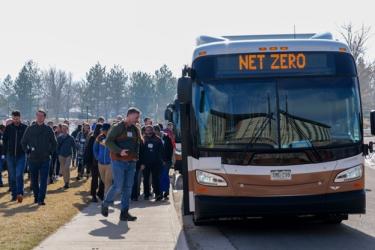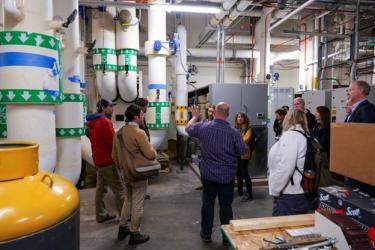 On Feb. 15, representatives from college and university campuses across Colorado, along with other national leaders, visited CU Boulder for a day of focused exploration on sustainability efforts in laboratories. It was an opportunity for CU Boulder to share innovations and lessons learned from laboratory sustainability while also learning about other steps to address the issues of sustainability from other universities and the State of Colorado Energy Office. The event was a collaboration between CU Boulder’s Environmental Center, Infrastructure and Sustainability and the National Renewable Energy Lab (NREL).
On Feb. 15, representatives from college and university campuses across Colorado, along with other national leaders, visited CU Boulder for a day of focused exploration on sustainability efforts in laboratories. It was an opportunity for CU Boulder to share innovations and lessons learned from laboratory sustainability while also learning about other steps to address the issues of sustainability from other universities and the State of Colorado Energy Office. The event was a collaboration between CU Boulder’s Environmental Center, Infrastructure and Sustainability and the National Renewable Energy Lab (NREL).
Kathy Ramirez-Aguilar, the Green Labs Program Manager, gave one of the opening presentations for the Net Zero Forum with a presentation on the Green Labs Program, including changes in research culture and funding structure that would lead to significant efficiency improvements in laboratories. Ramirez-Aguilar pitched the idea of creating the CU Boulder Green Labs Program to the university in 2009. It was one of the first green labs programs to be established and is considered a leader in the field. Ramirez-Aguilar emphasized the value and necessity of lab sustainability efforts by sharing some compelling statistics from CU Boulder’s Energy Master Plan.
“Even though major research buildings only occupy approximately 22% of campus square footage, those research buildings are responsible for 42% of campus building energy use,” said Ramirez-Aguilar.
Sustainability efforts in laboratories can have amplified benefits, since labs use a disproportionately large amount of resources, including electricity, water, chemicals and single-use plastic products. Improved efficiency in labs can help campuses achieve cost savings and also, reach their sustainability goals. For example, CU Boulder’s Climate Action Plan has a goal of 50% reduction of emissions from electricity and natural gas by 2030. Initiatives like the Green Labs Program are key to helping to avoid and minimize energy usage through its engagement of campus scientists in best practices, which also helps to reduce emissions.
Attendees to the Net Zero Forum saw some of CU Boulder’s sustainability efforts in action, including a ride in its electric buses and a tour of lab and mechanical spaces in the Jennie Smoly Caruthers Biotechnology Building. The building is one of few laboratory buildings to have received a LEED Platinum certification. Shannon Horn, who is the lead mechanical engineer for campus, presented on how significant energy efficiency is achieved for the building through its design, rightsizing and its mechanical and electrical systems.
In addition, the importance of research equipment sharing (via core facilities) was a message that was shared multiple times throughout the day including an afternoon kick-off presentation by Joe Dragavon on behalf of the CU Boulder Research Innovation Office. In their presentations, both Dragavon and Ramirez-Agular raised the point that core facilities benefit efficiency in science (including lab space optimization) and enable inclusive access to research resources. Ramirez-Aguilar highlighted BioCore Shared Instrumentation as a program that, with expansion on campus, would increase accessibility through its efforts to transition underutilized or unused equipment resources in individual labs to shared resources available to all. In just the first four years of the BioCore program being implemented in three laboratory departments, about $3 million was saved as a result of access to shared resources or redistribution of resources.
All of these steps towards lab sustainability are a collaborative effort and encompass constituents from across CU’s campus. These include scientists, staff supporting research, safety professionals, building managers, facilities operations, campus engineers, planners, energy managers, sustainability professionals and more.
“It takes a village to truly advance sustainability in scientific laboratories,” said Ramirez-Aguilar.
 Several other guest presenters highlighted work they are doing to contribute to sustainability. CU Anschutz shared information on a “Lab Cleanup” project their School of Medicine undertook in late 2021. The project assessed 550,000 square feet of laboratory space and resulted in the clean up of 44,000 square feet. It included repurposing unused research supplies and equipment, looking for opportunities to share resources and disposing of unwanted or broken legacy equipment, computers, biological materials and chemicals. The clean up avoided the need for CU Anschutz to build another lab building. The project demonstrated not only the sustainability benefits of such a project, but also the cost savings that can come from such an undertaking.
Several other guest presenters highlighted work they are doing to contribute to sustainability. CU Anschutz shared information on a “Lab Cleanup” project their School of Medicine undertook in late 2021. The project assessed 550,000 square feet of laboratory space and resulted in the clean up of 44,000 square feet. It included repurposing unused research supplies and equipment, looking for opportunities to share resources and disposing of unwanted or broken legacy equipment, computers, biological materials and chemicals. The clean up avoided the need for CU Anschutz to build another lab building. The project demonstrated not only the sustainability benefits of such a project, but also the cost savings that can come from such an undertaking.
In addition to saving space, resources and money, efforts like the Green Lab Program have the important advantage of laying the cultural foundation of sustainability for students, researchers and scientists who may move into careers outside of academia. Industries such as biopharma, equipment development and manufacturing and policy implementation all can benefit from the ethos developed around sustainability at the academic level.
Collaborations like the Net Zero Forum Exchange are an opportunity for colleges and universities to come together and help proliferate best practices, so that their work and impact can move beyond their own institutions, towards a broader vision of sustainability across the U.S. and beyond.
“This is an exciting time. There is a lot happening in Europe where funders in multiple countries are in the process of connecting environmental sustainability expectations with receiving research funding,” said Ramirez-Aguilar. “I'm hoping we see similar signs of progress to come from funders within the United States.”

